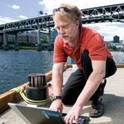
Contribution to Book
Estuarine turbidity maxima revisited: Instrumental approaches, remote sensing, modeling studies, and new directions
Fluvial-Tidal Sedimentology
(2015)
Abstract
Estuarine turbidity maxima (ETM) are zones of elevated sediment concentration that often occur in coastal plain, salt wedge, and river-dominated estuaries, where they influence the morphodynamic development, biogeochemical cycling, and contaminant redistribution of these systems. In this review, we examine recent advances in in situ and remote sensing techniques that can be used to improve our understanding of ETM, summarize recent theoretical and numerical modeling results, and define a series of research questions for the next decade. New acoustic configurations and instruments have the potential to address gaps in current observational capabilities and understanding, for example by providing better definition of vertical and horizontal sediment fluxes. Higher resolution (meter scale) ocean color remote sensing will allow visualization of small-scale features such as frontal boundaries and turbulent eddies in a manner that has not previously been possible. Increasing spectral resolution in ocean color images will allow development of improved algorithms to quantify sediment concentrations remotely. Additionally, the in-water optical techniques used to validate and develop algorithms for ocean color remote sensing can be adapted to estuaries, and are often amenable to rapid survey modes of deployment. In sum, these techniques provide opportunities to improve ETM models and theory.
Recent theoretical analyses of the profiles of velocity and suspended sediment concentration (SSC) in estuaries, integral analyses of ETM SSC conservation, and numerical model studies provide important insights into the response of ETM to external forcing and the mechanisms behind ETM particle trapping. However, existing studies produce more questions than answers. For example, it is still not possible to predict, except in very general terms, what trapping mechanisms will be active in different kinds of estuaries, and whether multiple ETM can be expected. The role of nonstationarity, extreme events, and climate change (e.g., mean sea level (MSL) rise and altered flow regimes) on ETM dynamics have not been systematically investigated, and feedbacks between anthropogenic influences and other system changes remain poorly understood. We summarize possible future analysis paths in terms of 10 research questions.
Disciplines
Publication Date
2015
Editor
Philip J. Ashworth, James L. Best and Daniel R. Parsons
Publisher
Elsevier
Series
Developments in Sedimentology
ISBN
9780444635297
DOI
10.1016/B978-0-444-63529-7.00004-3
Citation Information
David A Jay, Stefan A. Talke, A. Hudson and Michael S. Twardowski. "Estuarine turbidity maxima revisited: Instrumental approaches, remote sensing, modeling studies, and new directions" Fluvial-Tidal Sedimentology Vol. 68 (2015) p. 49 - 109 Available at: http://works.bepress.com/david_jay/49/
